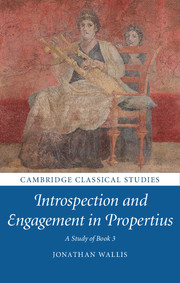Book contents
- Introspection and Engagement in Propertius
- Cambridge Classical Studies
- Introspection and Engagement in Propertius
- Copyright page
- Contents
- Preface
- Introduction
- Chapter 1 Turning Elegy Upside Down
- Chapter 2 Seeking Fides in Poets and Poetry
- Chapter 3 Thematic Experimentation
- Chapter 4 Marriage and the Elegiac Woman
- Chapter 5 Delays and Destinations
- Chapter 6 A Hymn to Bacchus
- Chapter 7 In Lament for Marcellus
- Chapter 8 Renewing an Elegiac Contract
- Chapter 9 Breaking up (with) Cynthia
- Epilogue
- Bibliography
- General Index
- Index Locorum
- References
Bibliography
Published online by Cambridge University Press: 14 April 2018
- Introspection and Engagement in Propertius
- Cambridge Classical Studies
- Introspection and Engagement in Propertius
- Copyright page
- Contents
- Preface
- Introduction
- Chapter 1 Turning Elegy Upside Down
- Chapter 2 Seeking Fides in Poets and Poetry
- Chapter 3 Thematic Experimentation
- Chapter 4 Marriage and the Elegiac Woman
- Chapter 5 Delays and Destinations
- Chapter 6 A Hymn to Bacchus
- Chapter 7 In Lament for Marcellus
- Chapter 8 Renewing an Elegiac Contract
- Chapter 9 Breaking up (with) Cynthia
- Epilogue
- Bibliography
- General Index
- Index Locorum
- References
Summary
- Type
- Chapter
- Information
- Introspection and Engagement in PropertiusA Study of Book 3, pp. 225 - 235Publisher: Cambridge University PressPrint publication year: 2018



